Table of Contents
The proposed complete dismantling of the car removes all copper-containing parts; hence, the bales prepared from the clean ferrous metals should contain only the 0.07 percent copper that is in solid solution in the steel. As the baled steel weighs 2,614 pounds, it contains about 1.8 pounds of copper. If the upper limit of high-quality No. 2 bundle, is set at 0.1 percent copper, an additional 0.8 pound of copper can be tolerated. The typical car contains about 1.3 pounds of brass (0.9 pound copper) in bushings and rivets in the differential, transmission, and brakes, As separating the brass from these parts requires about 15 minutes, the $1.09 cost of recovering these brass items far exceeds the $0.40 worth of brass recovered, However, if these parts were not separated so as to make the process more economical, the steel produced would be marginal as to copper content.
An inspection of the data presented in table 3 reveals that numerous other parts, which must be stripped from the car, either do not warrant disassembly to recover salable metals or such disassembly is economically marginal. These include the window frames, interior trim, radio, fuel pump, distributor, brake drums and cylinders, and horn and relay, If the items are stripped and discarded instead of disassembled, the loss of income is only $2.55, whereas the saving in cost of labor is $5.32.
Scrap yards have developed other methods for making metal separation than those recorded in this report. For example, Wasatch Metal & Salvage Co. of Salt Lake City, Utah, separates the metallic components within engines by utilizing a baler. Engines are dropped into a baler and crushed, the cast iron and steel are lifted from the baler by a magnet and placed on a table where the steel and cast iron are hand sorted, and the aluminum and zinc die cast remain in the baler from which they are periodically removed. The resulting products are not nearly as clean as achieved by hand stripping, even though the dismantling time is considerably reduced. Laboratory handtool dismantling required 44.2 minutes for complete dismantling versus 11.3 minutes using the baler method.
A number of other changes in scrap yard technology might be devised to lower costs and increase income from sale of products. For example, the cost of operating a smokeless incinerator is a significant part of the overall cost of operating a dismantling yard, and a simpler, more efficient, and lower cost unit probably can be devised. Controlled burning in such an incinerator might permit selective melting and recovery of the low-melting zinc die cast, with significant decrease in cost of its removal and recovery. As the front and rear bumpers are easily removed and contain over 1 pound of nickel, it may be possible to devise an economic heat treating means for removing and recovering this metal to enhance the quality of the No. 2 bundle. Thus, if the clean No. 2 bundles postulated by this study as being obtainable were shredded, the cost of producing clean shredded scrap would be slightly more than $25 per ton. Since this is less than the average price of shredded scrap, this type of operation would also be attractive and profitable.
For the last 10 years the number of cars discarded annually has increased sharply while markets have shrunk for No. 2 bundle steel, the chief product of automobile scrapping. Estimates vary, but over 15 million rusting car hulks have accumulated in ugly piles scattered from coast to coast. At least 6 million more cars are discarded every year. The accumulated hulks, which now comprise over 26 million tons, chiefly metals, constitute a major waste of ferrous and nonferrous metals.
The usual auto scrapping procedure, consists of stripping the car of reusable parts by wrecking yard operators, followed by open air incineration to remove the rubber, textiles, and other combustibles. Scrap yards then remove the cast iron, heavy steel, and accessible nonferrous components, and bale the residual shell as No. 2 bundles. This method of scrapping leaves appreciable copper, zinc, and aluminum in the No. 2 bundles, together with minor amounts of nickel, chromium, and lead.
In recent years some automobile scrap processors, in the face of decreased demand and lower prices for No. 2 bundles, have adopted other methods to produce a better quality and more acceptable steel product. One method involves fragmentation of partly stripped automobiles, followed by magnetic separation to produce fist-sized steel chunks. Another method comprises dismantling, stripping, incinerating, and shearing into slabs.
In the fragmentation process, automobiles less tires, battery, gas tank, radiator, engine, and transmission are fed into hammer mills or other shredding devices. The discharge of the mill is then passed through magnetic separators to reject the nonferrous metals and nonmetals. Some of the nonferrous metals are recovered from the nonmagnetic product by hand sorting, the remainder going to waste. This method offers low operating cost in large-capacity plants and in most cases can eliminate the need for incineration. The shredded steel scrap may contain up to 0.23 percent copper. Furthermore, economic use of fragmentizers requires a large capital investment for the plant and a constant large supply of scrap automobiles. For these reasons use of the shredding method may be limited to major urban centers and to preparation of metal to be used in making rebars, angle iron, and similar steel items not requiring low copper content.
The production of sheared slabs by automobile scrap processors involves carefully stripping each car of tires, radiator, battery, and most of the copper, aluminum, and zinc base die castings. After incineration, the motor and transmission, if not previously removed, are cut from the car shell; the burned hulk is then cut into small slabs. The slabs are dropped on a shaking conveyor to loosen and reject dirt, glass, ash, and entrapped nonferrous metals. This method features relatively low capital investment in new equipment and flexibility as to size of plant for economic operation. With careful stripping of copper-bearing components before baling, good-quality steel slabs containing as little as 0.12 percent copper have been produced. Incineration is mandatory and operating costs are higher than in large-capacity fragmentation plants. A steady source of low-cost scrap automobiles is essential.
To be fully acceptable to the steel industry, auto scrap should contain less than 0.1 percent copper and be essentially free of zinc and aluminum. As such scrap is essentially free of nonferrous impurities, the open hearth or basic oxygen furnace dusts produced would be zinc free and hence suitable for recycle instead of presenting another problem of solid waste disposal. This quality scrap theoretically can be produced, provided the scrap automobile is carefully stripped of nonferrous metal parts and wire before baling or fragmentation.
Discussions with automobile manufacturers and scrap processors revealed that there are no reliable data available on the precise distribution of non- ferrous metals in typical scrappable automobiles or on the costs of removing the innumerable nonferrous metal-bearing components to achieve the desired quality steel scrap, although such data are indispensable for efficient preparation of the automobile for disposal as acceptable scrap. To obtain such data, a study was made at the Bureau of Mines Salt Lake City Metallurgy Research Center (SLCMRC) of 15 scrap automobiles. The selected cars were carefully dismantled, and the parts were separated into clean component metal products for weighing and analysis. Alternative means and methods of stripping and dismantling the cars were timed. Based on the data obtained, a cost evaluation was made for scrap car processing via burning in an incinerator versus hand tool dismantling to produce high-quality steel and cast iron and salable copper, lead, zinc, and aluminum metal byproducts.
Composite Automobile
The following factors were considered to insure that the cars selected for dismantling and analysis would be representative of a composite abandoned automobile:
- Age of cars. A survey of automobiles abandoned in 1965 in both urban and rural areas revealed 9, 56, and 35 percent of the cars were, respectively, 1 to 7, 8 to 12, and over 12 years in age. Hence, only those cars manufactured between 1954 and 1965 were included in the composite automobile. Such cars should be representative of current vehicles received by scrap processors and should comprise an appreciable portion of abandoned automobile receipts during the coming 5 years.
- Make of car and body type. Selection of the 15 automobiles for study was based on the premise that the types and models of the abandoned vehicles would be in the same proportion as that of the cars originally manufactured. The number and percentage of production ascribable to each make of automobile are given in table 1. The type of bodies produced, although of lesser concern, was also considered in the selection. From 1954 to 1965, the average production of the various types were two- and four-door sedans, 52 percent; two- and four-door hardtops, 30 percent; two – and four-door station wagons, 13 percent; and all others, 5 percent.” Recent trends reveal production of a larger proportion of compact cars and a major increase in the manufacture of hardtops rather than sedans.
- Automobile auxiliary equipment. Installation in automobiles of certain convenience equipment has increased appreciably in recent years, as shown in the following tabulation:
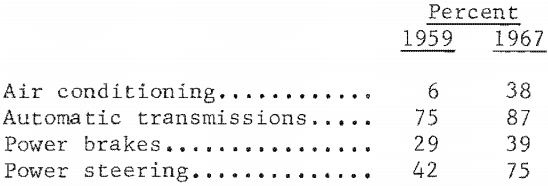
Power windows were installed in many expensive automobiles, but not in lower priced cars. Of the cars comprising the composite automobile, only one had power brakes, power windows, and air conditioning; three had power steering. Most of the cars contained radios and were equipped with automatic transmissions. The presence of the air conditioner in one car did not materially change the copper content of that car, but did increase the aluminum content.
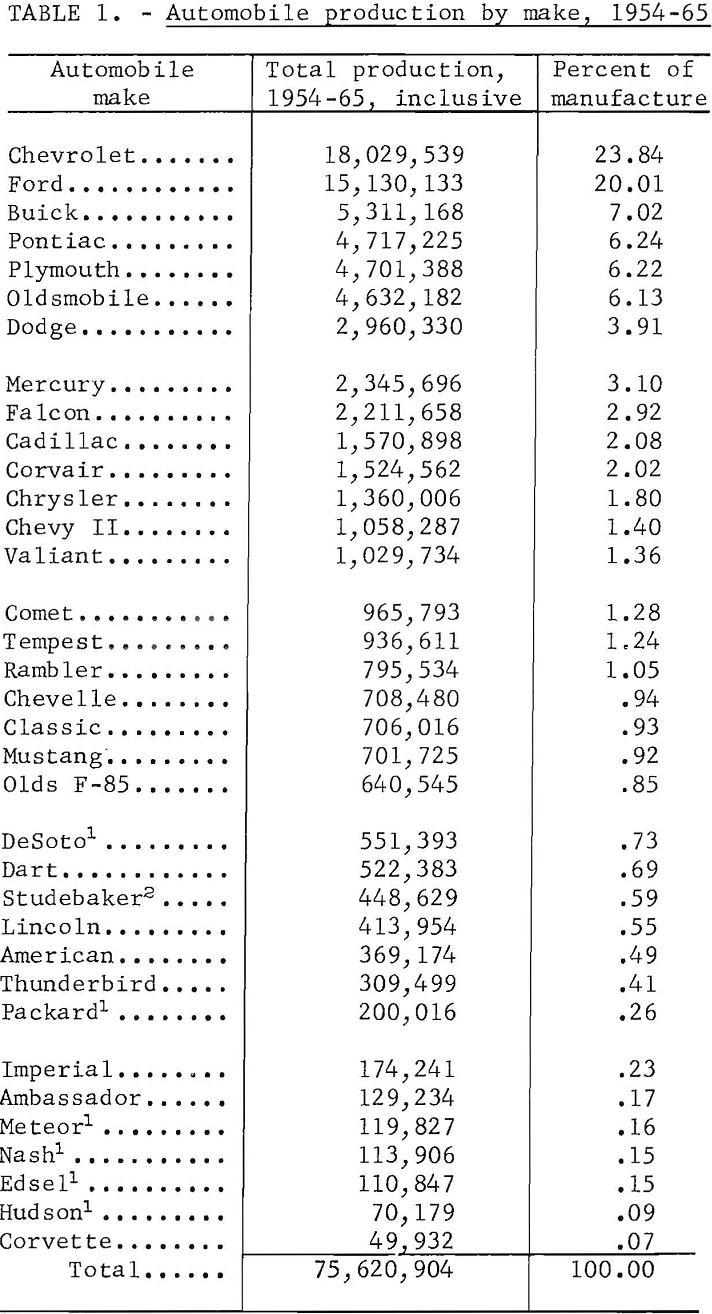
Based on the stated considerations, the automobiles as listed in table 2 were dismantled and analyzed.
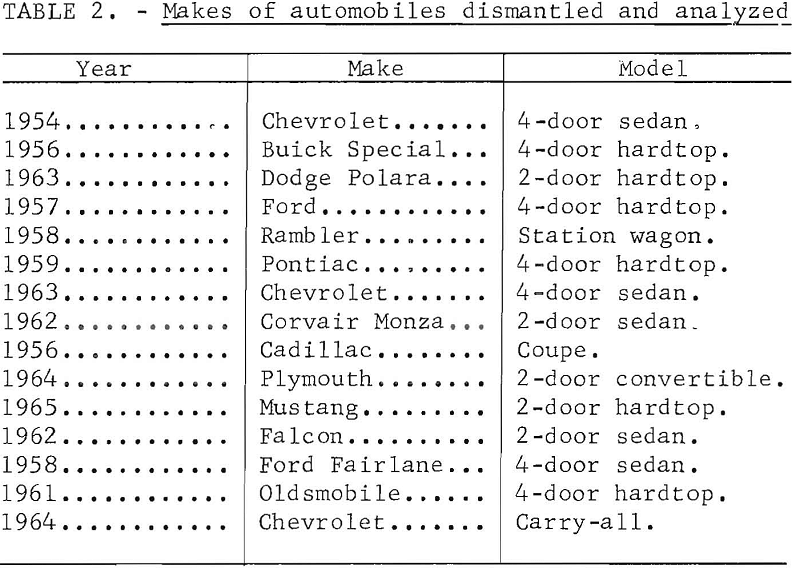
The automobiles were procured from wrecking yards, scrap processors, or insurance salvage firms. All the later models were bought as “totaled out” wrecks from an insurance salvage firm to keep procurement costs to a modest level. Although the cars were “total wrecks,” care was taken to obtain as complete a car as possible, or at least to insure that if a part was missing, such as a headlight, a duplicate part was available.
Dismantling Studies
The selected 15 automobiles were dismantled into component parts, and the metal parts were separated into different classes of ferrous and nonferrous metals using a variety of hand and power tools and a cutting torch. The separated metals and nonmetals were weighed, sampled, and chemically analyzed to determine their nonferrous metal content. Data from the study of each of the 15 cars were summarized in unpublished memoranda reports on file at the Bureau of Mines Metallurgy Research Center in Salt Lake City, Utah. These studies, which included recording the time required to separate the parts from the car and then disassemble the metal parts, were subsequently complemented by comparable time and motion studies made of local automobile scrap yard personnel dismantling several incinerated cars. The information derived from these studies was consolidated as averages for a composite car processed by incinerator burning and complete dismantling and preparation into marketable cast iron, No. 2 bundle steel, and nonferrous metal products. The consolidated data are given in table 3.
The data given in table 3 show that dismantling a composite automobile into component parts requires about 2 man-hours and that disassembling the parts to remove and recover the nonferrous metals requires about 3.5 man-hours.
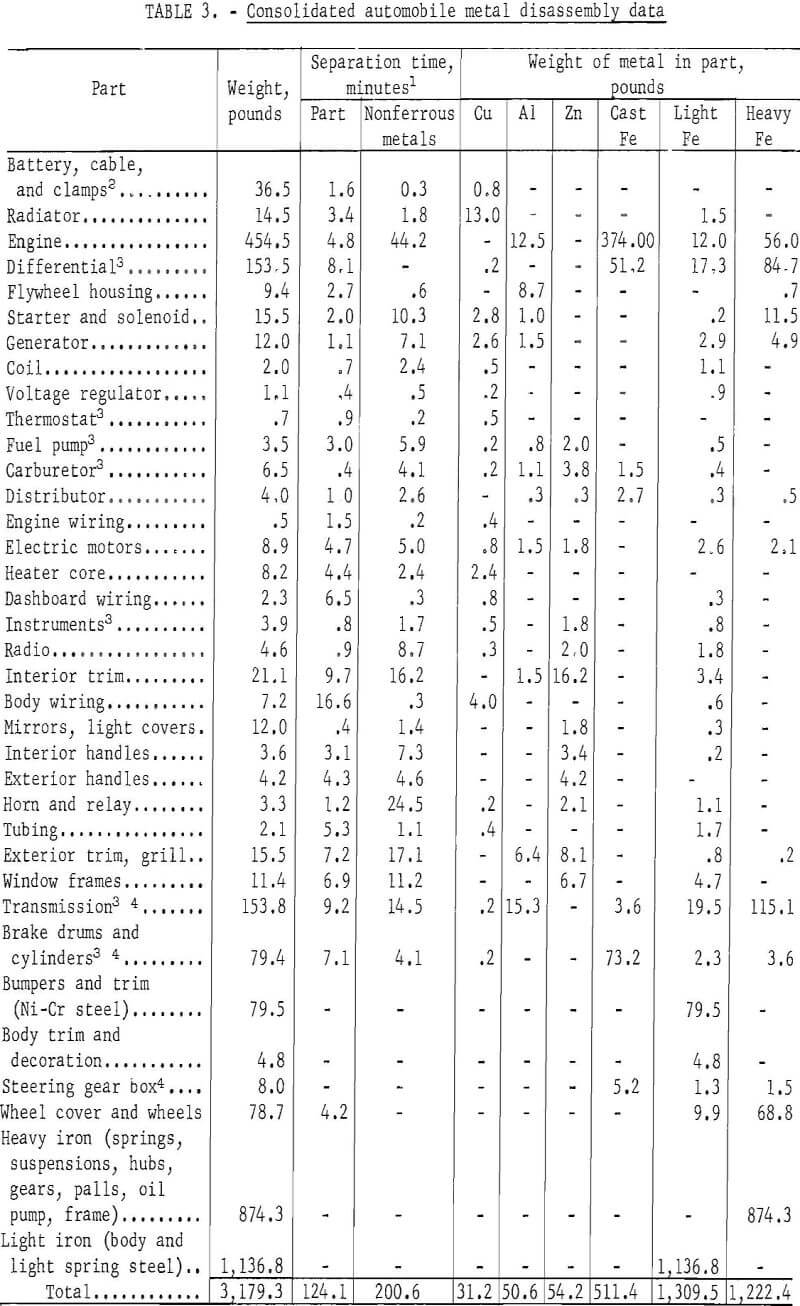
The composite car contains about 31.2 pounds of copper in removable parts. The aluminum in the car is calculated to be about 52.8 pounds, present chiefly as sheet in the grill and trim, and as castings in the engine and transmission housings. The aluminum (2.2 pounds) alloyed with zinc in die cast metal is not recorded separately as it is not separately recoverable. All the zinc listed in table 3 is in the form of zinc base die castings. Only about 0.7 pound of zinc is present in the car as brass and is disposed of as yellow brass solids with no credit for zinc. This 0.7 pound of zinc is not included in the total metal weight in table 3.
The analysis reveals that the clean steel from the typical car contains about 0.07 percent copper, presumably in solid solution in the steel. Hence, meeting a specification of no more than 0.1 percent copper in baled steel requires almost complete separation of copper-bearing parts from steel parts.
The composite auto derived from the data obtained in dismantling and analyzing the 15 automobiles is a 10-year-old, four-door sedan, in the low-price class, with automatic transmission, radio, and heater, and of modified unitized body design.
The composition and weight of the components of the typical automobile are given in table 4.
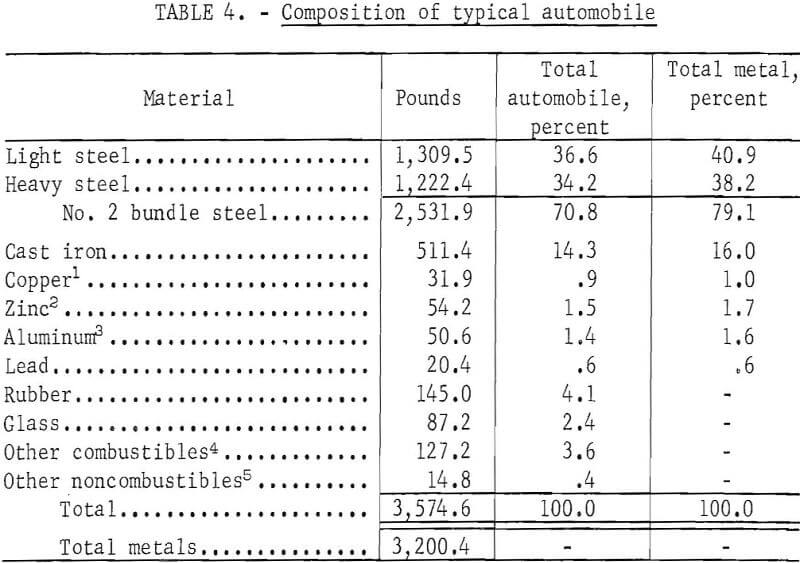
Figure 1 depicts the variety of materials segregated into types that comprised one of the 15 dismantled automobiles.
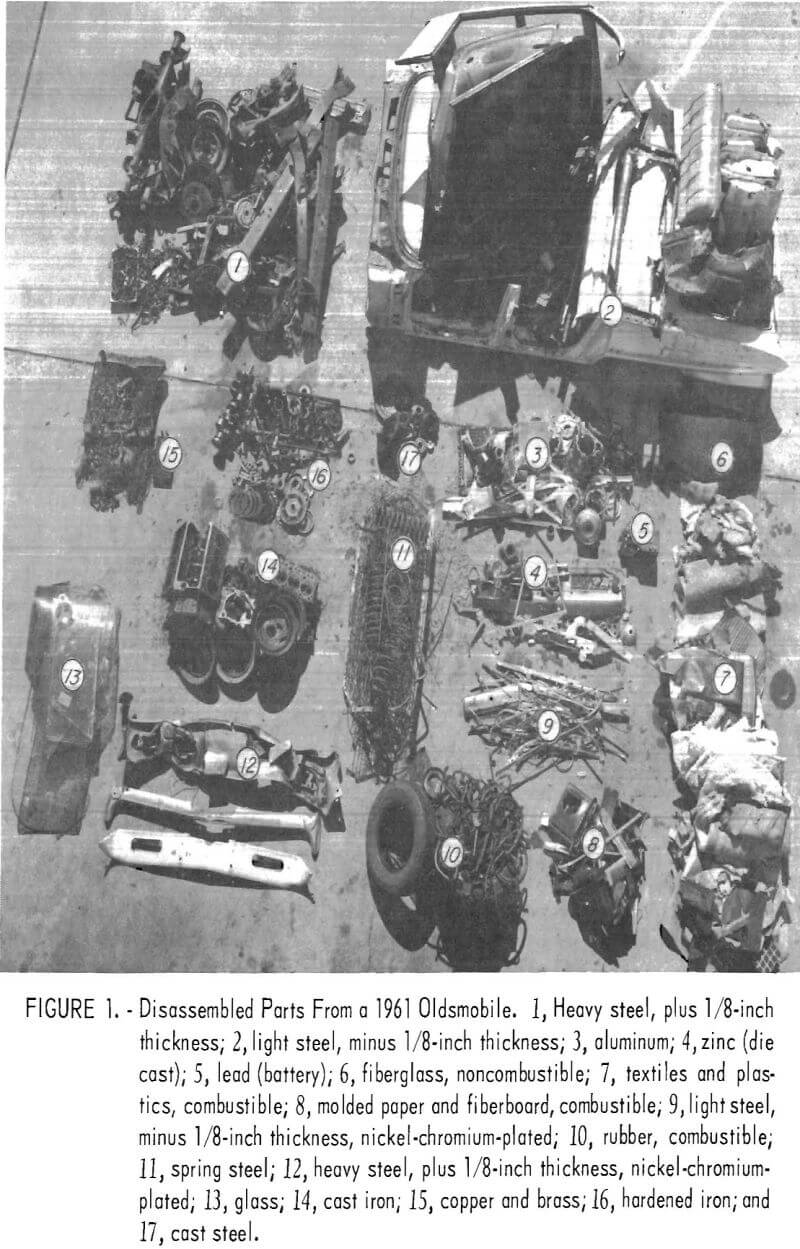
Recovery and Value of Metals in the Composite Car
Complete dismantling of the automobile and disassembly of the hundreds of parts to separate and recover all different classes of ferrous and nonferrous metals is impractical. For this reason, an analysis of the available data on the amount, distribution, and physical relation of the different metals was made to determine the weight and nature of the different metal products that could be recovered and marketed.
Ferrous Components and Values
The ferrous components of an automobile are usually disposed of in three groups: (1) cast iron, (2) No. 2 heavy melting, and (3) No. 2 bundles.
The cast iron is present in the motor block, heads, brake cylinders and drums, intake and exhaust manifolds, power steering housing, transmission, water pump, and miscellaneous parts. If the cast iron is separated from non-ferrous impurities and steel, the product can be sold as clean auto cast at a premium price. However, not all cast iron is recoverable. The brake drums and cylinders contain 73.2 pounds of cast iron that cannot be readily separated from light and heavy steel. The steering gear box and differential contain 5.2 and 3.6 pounds of cast iron, respectively, which are not recoverable as such. The 82 pounds of cast iron in these parts will be included, therefore, in the No. 2 bundle material.
The No. 2 heavy melting stock consists of steel scrap at least 1/8 inch thick. This category includes the frame, springs, wheels, rear ends, generator and starter housings, bumpers, and motor bolts.
No. 2 bundles consist of used steel sheet compressed to a density of not less than 75 pounds per cubic foot and of charging box size. Tin, lead, and vitreous coated steel is excluded. Light body and fender automotive steel is a major component of No. 2 bundles.
The average values of these commodities in 1969, based on the principal national market places and randomly selected dates of February 21, May 1, and June 27, were clean auto cast, $42.20 per ton; No. 2 heavy melting, $22.40 per ton; and No. 2 bundles, $18.70 per ton. Based on these price assumptions, the ferrous components in the composite auto have a combined value of $33.50, presented in table 5.

Nonferrous Components and Values
The recoverable nonferrous metals in a typical automobile are copper as radiator stock, copper wire, and brass; aluminum in the form of scrap sheet and castings; lead in battery clamps and battery; and zinc in the form of zinc base die castings. In addition the typical car contains about 5 pounds each of nickel and chromium, partly in alloy steels and partly as nickel and chrome plate on bumpers and other parts. Although nickel- and chromium-containing parts such as bumpers might best be eliminated from high-quality No. 2 bundle steel, for this report the bumpers are included in the No. 2 bundle compilation.
Copper serves in functional rather than decorative uses in automobiles. About 31.2 pounds of copper are present in widely distributed removable forms, and about 1.8 pounds are dissolved in the steel components. Nearly 82 percent of the removable copper in an automobile is located forward of the firewall in such major copper-containing parts as the radiator, generator, starter, heater core and motor, and battery cable. The remaining 18 percent of the copper is in the instrumentation, body wiring, and miscellaneous items such as tubing connectors and the radio.
Scrap processors dispose of automotive copper in two forms: The radiators and heater cores are sold as radiator stock and the remaining copper material as No. 2 heavy copper and wire. Additionally, if the car is completely stripped, there would be 2.7 pounds of brass bushings, valves, sleeves, and rivets available for disposal. These 2.7 pounds of brass contain 2.0 pounds of copper, February, May, and June 1969 average prices quoted for these items, in cents per pound, were radiator, 32.75; No. 2 heavy copper and wire, 47.8; and yellow brass solids, 31. The heavy copper and wire figure, however, is considered to be high in that a dock strike in February and other factors may have produced an artificially high price. The figure used in this report is 39.6 cents per pound, which was the average price for this commodity for the entire year of 1968.
The recoverable and salable copper items in a composite automobile are 15.4 pounds of radiator stock, 13.8 pounds of No. 2 heavy copper and wire, and 2.7 pounds of yellow brass. At the assumed market value for these classes of scrap copper, the recoverable copper in the composite automobile has a value of $11.34. Some copper, principally body wire, is oxidized during incineration, but such losses would not seriously affect the economics.
Zinc also is located throughout the automobile in both decorative and functional parts. Exterior use of zinc base die castings includes door and trunk handles, locks, nameplates, window frames, outside trim, grill, etc. Interior use, including motor items, consists of interior trim, motor cases, horn rings and horns, fuel pump, carburetor, distributor, inside door handles, instruments, etc. The 54.2 pounds of zinc die castings are worth about 6.25 cents per pound with a total value of $3.39. During incineration, part of the zinc base die castings melts, and this metal is subsequently recovered and sold. A small part of the zinc base die cast alloy also may oxidize, but this possible loss was ignored in the calculation of recoverable values.
As with the copper, about 82 percent of the aluminum in an automobile is located in the engine, transmission, and accompanying parts. The remainder is present in the grill, and in the interior and exterior trim. The 50.6 pounds of separable aluminum in a composite automobile at 12.4 cents per pound has a total value of $6.27.
Most of the lead in an automobile is in the battery and battery cable clamps. Small amounts of lead are present in the radiator, heater core, and bearings and in older cars in appreciable quantities as a seam and body filler. None of the filler and bearing lead is recoverable by the scrap processor. The battery and battery cable clamps contain 20 and 0.4 pounds of lead, respectively. The battery may be sold as is, or it may be dismantled and the lead sold to refiners. An average battery weighs approximately 36 pounds, and the 20 pounds of contained lead is worth 11 cents per pound to the refiner or a total of $2.20. However, most scrap processors prefer to sell the batteries intact at a price of approximately $1.40, and this figure is used in this study. Thus, the total recoverable lead values in an automobile would be $1.40 for the battery plus $0,044 for the clamps or approximately $1.44 per car.
The total value of recoverable ferrous and nonferrous metals in the composite automobile is presented in table 6.
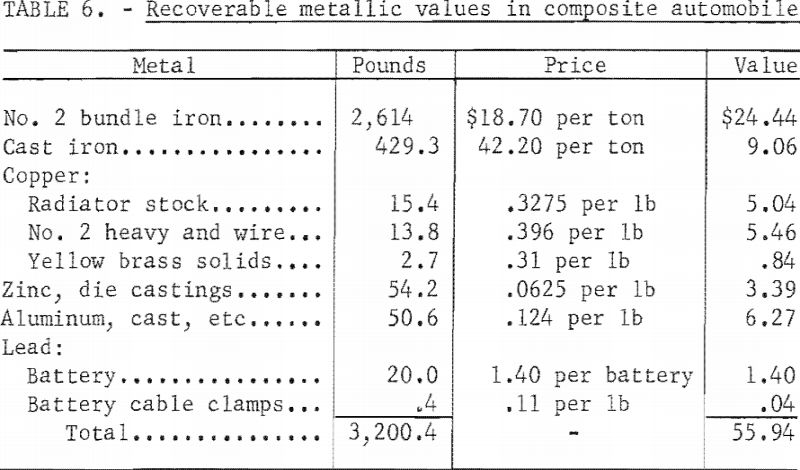
Postulated Scrap Yard Operations
A preliminary cost estimate of automobile dismantling practices indicated marketable quality steel, cast iron, and nonferrous metal product could be produced at a lower cost than the market value of the products. To examine this tentative conclusion in further detail, a scrap yard operation to dismantle 48 cars in an 8-hour day was postulated and a cost evaluation was made of this operation. Such an operation could process the cars discarded by about 300,000 people living within an economic transportation radius of the proposed plant.
The following assumptions were made in designing the proposed operation:
- As the dismantling studies revealed a significant income could be derived from selling metals from the radiator, heater core, and battery, the postulated scrap yard would process entire automobiles delivered to the yard and purchased for $9 per car.
- As hand removal of the widely distributed cardboard, plastics, padding, and textile components of a car is uneconomic, incineration was deemed necessary. Hence, the proposed scrap yard operation included automobile burning in a smokeless incinerator. An incinerator with a designed capacity to burn two cars at a time and six cars per hour is undergoing break-in tests at a local automobile scrap yard. As operating costs for this incinerator are not yet available, 1961 cost data, given in a report describing operation of a comparable incinerator, were updated. The updated capital and operating costs for the 48-car-per-day incinerator were $22,000 and $4.30 per car, respectively. The postulated incinerator with approximately the same capital cost but greater throughput capacity should be capable of markedly reducing the $4.30 per car incineration cost.
- All light and heavy steel, including frame and bumpers, together with about 82 pounds of cast iron that cannot be easily segregated from transmission, brake drums and cylinders, and steering gear box are baled as No. 2 bundle steel and sold for $18.70 per ton. The cast iron parts (429 pounds) easily separated from the car and engine would be sold for $42.20 per ton.
- The copper, aluminum, zinc, and lead metals and alloys in the component parts of the car would be separated from the ferrous metals to insure preparation of high-quality steel scrap. The respective nonferrous metal products would be sold at average prices.
- The dismantling, disassembly, and baling operations would be achieved with standard equipment and tools available in most small scrap yards.
Based on the stated assumptions and the data presented in table 3, for dismantling cars, a hypothetical scrap yard operation was designed for handling 48 cars per day, including receiving, burning in a smokeless incinerator, complete disassembly, and baling. The method of operation together with the calculated man-minutes required per car for the arbitrarily grouped steps is described as follows:
- A receiving clerk checks car and title, directs owner to wheel removal area, completes transfer and sale papers, and pays owner for car. Time required: 5 man-minutes.
- Two yardmen remove wheel covers and wheels, cut tires from wheels, remove battery, battery cable, and radiator, and separate and stack the materials. Time required: 16 man-minutes.
- A crane operator with the assistance of a yardman picks up the wheelless car, swings it to the incineration area, and drops car to break the glass and spring open the trunk. The yardman punctures and drains gas tank and assists the craneman in placing two cars on a steel cart. When the previous cycle is completed, yardman splashes fuel oil on car’s upholstery and the cart is positioned in incinerator where ignition and combustion takes place. Time required: 10 man-minutes.
- A yardman cuts motor and transmission from cool cars in the incineration area. Craneman with assistance of yardman moves body, including frame, rear end, and bumpers, to baling area and motor and transmission to dismantling area. Time required: 20 man-minutes.
- A crew of 10 yardmen cut starter and generator from motor and completely disassemble the transmission and motor to separate and store the different kinds of ferrous and nonferrous metals. Time required: 87 man-minutes.
- Two yardmen crush, burn, and disassemble generator, starter, and solenoid, and then separate and store copper, aluminum, and steel products. Time required: 18 man-minutes.
- Eleven yardmen remove and disassemble the exterior trim, grill, mirror, window frames, exterior handles, head and tail lights and body wiring, horn and relay, voltage regulator, and tubing. Time required: 97 man-minutes.
- Ten yardmen remove and disassemble the interior trim, dashboard wiring, instruments, radio, heater core, mirrors, electric motors, and interior door and window handles. Time required: 88 man-minutes.
- Crane operator and truck driver collect and move to baler and shipping area, as required, the accumulations of clean steel, cast iron, copper, aluminum, and zinc base die casting. Time required: 8 man-minutes.
- Stripped hulk is moved to baler by craneman with help of a yardman and then baled and discharged into gondola railroad car by baler operator. Time required: 10 man-minutes.
By the described operation, about 6 man-hours are required to receive burn, dismantle, separate, bale, and prepare for shipment the metals within an automobile. The required work crew for processing 48 cars per day comprises one receiving clerk, one wheel yardman, three miscellaneous yardmen, two cranemen, 10 dismantling yardmen, 11 exterior and 10 interior stripper yardmen, one baler operator, one baler yardman-truck driver, and two generator-starter yardmen. The number of men required is based on a workday of 7 effective work hours, considering normal off time and contingencies.
The hypothetical scrap yard for processing 48 complete cars per day is estimated to require 5 acres of fenced land adjacent to a railroad spur. Three buildings with adequate space for offices, dismantling shops, and storage are required. Major equipment includes a smokeless incinerator, a baler, two cranes, boom truck, pads, dismantling conveyor, pickup truck, alligator shears, press, and lathe. A stock of handtools, impact wrenches, cutting torches, mechanical metal cutting saws, and safety equipment is also necessary.
Cost Evaluation
Based on the data given for the described operation, a cost evaluation was made for the hypothetical scrap yard. Tables 7 and 8 give the estimated capital and operating costs as of 1968. Table 9 gives the estimated discounted cash flow rate of return before taxes, assuming the separated metals are sold for $55.94 per car. The cost per automobile for recovering this value would be $51.24. A comparative estimate is made for open field incineration instead of employing a smokeless incinerator.
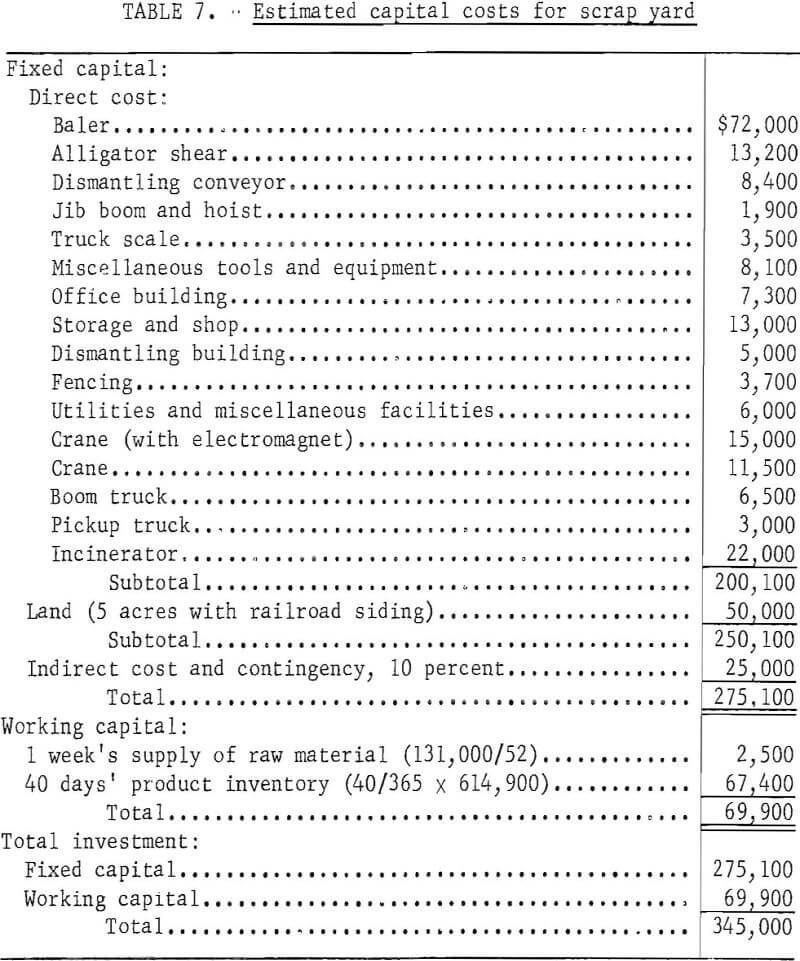
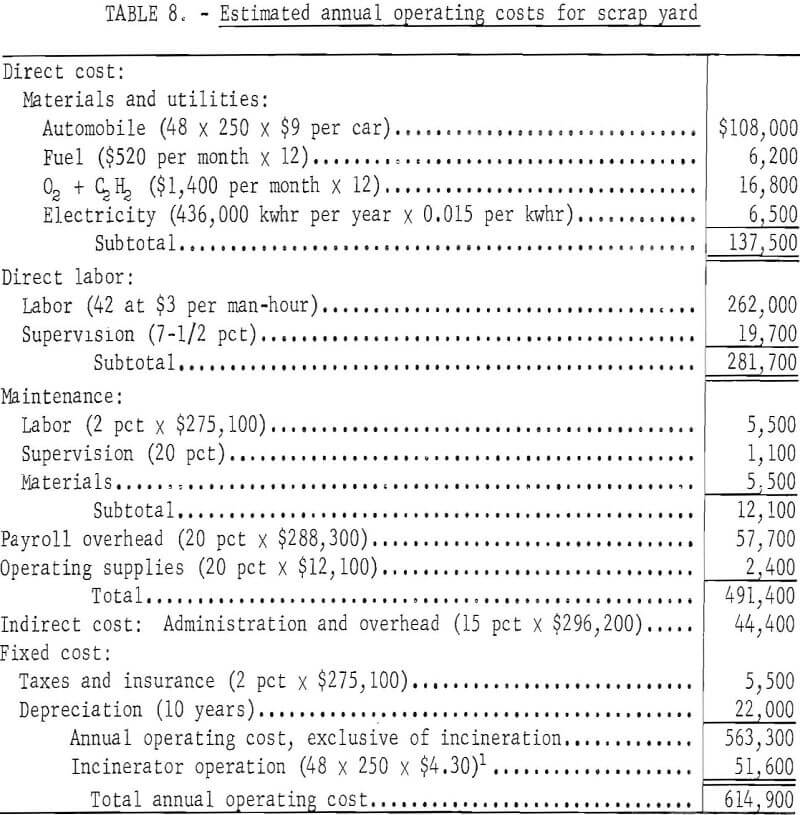

The annual rate of return is based upon standard accounting procedures which discount annual cash flow and recovery of working capital plus salvage value of the land ($50,000) to the evaluation date. The annual rate of return is 19.0 percent for the smokeless incinerator operation. A similar calculation for a scrap yard employing open field incineration showed an annual rate of return of 41.3 percent because of a $30,400 lower investment and a $54,200 lower annual operating cost.
Cost evaluation of the postulated scrap yard operation for processing 48 cars per day indicates that the dismantling of an entire car and disassembly of the component parts into readily marketed high-quality No. 2 bundles, clean cast iron, and copper, aluminum, and zinc metals and alloys is economically feasible. The total investment in the plant, fixed plus working capital, is estimated as $345,000. Overall operating costs to process 12,000 cars annually, based on plant depreciation over 10 years, is estimated at $614,900. Profit from sale of No. 2 bundle steel, cast iron, and nonferrous metal products is estimated as $56,620 per year.
Currently, many of the hulks received by the scrap processor from wrecking yards and garages are not complete cars. Some of the hulks have been burned, the battery, radiator, and engine have been removed, and sometimes the frame and transmission have been removed. The prices paid for less than complete cars vary downward as less than complete vehicles are received. Based upon a price of $9 for a complete vehicle, the prices would be as follows:
Complete automobile, less battery, but with radiator………………………………………………….$8.00
Automobile without battery and radiator, but with engine……………………………………………5.00
Automobile without battery, radiator, engine, and transmission…………………………………..2.00
A second cost evaluation was made to assess the economic practicality of processing 12,000 automobiles annually procured for $2 each without battery, radiator, engine, and transmission. The information derived is presented in table 10.
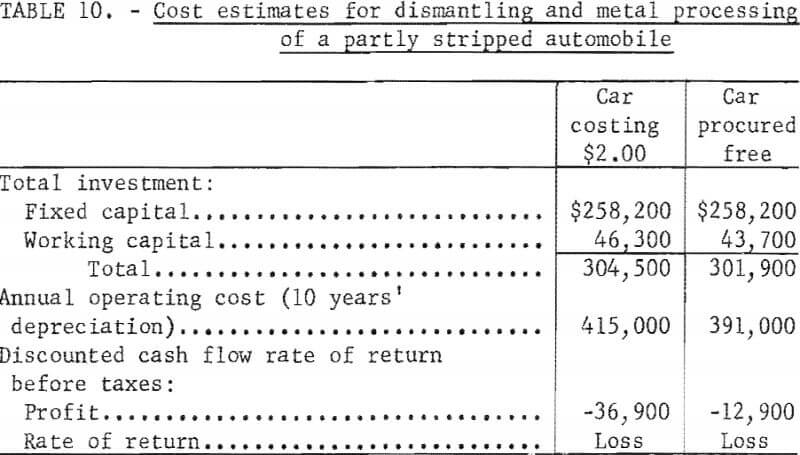
Note: Cars lack battery, radiator, engine, and transmission, and contain $31.51 in recoverable metal values. Labor force comprises 30 men.
